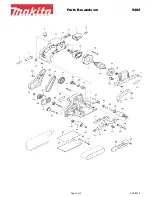
USING THE SANDER
SANDING PROCEDURE
The FLEX Profile Sander has been designed for one-hand operation (Fig. 15). The sander can
be easily guided over the work surface with one hand. The normal weight of the machine is
sufficient for efficient sanding. Do not put additional pressure on the machine. This would only
slow down the speed of the pad, reducing the sanding efficiency and put an additional burden
on the motor. In addition, it might cause the sander to jump on the work. Let the sander do the
work.
l
The Profile Sander uses an “in-line” sanding motion. The best surface finish will be achieved
while operating the sander “in-line” with the wood grain. Faster removal rates can be achieved
by operating the sander across the grain while working out rough areas, and then finishing by
sanding with the grain.
FINE FINISHING
The action of the FLEX Profile Sander causes thousands of tiny abrasive grits to move against
the work at high speed. Each grain moves in the same direction at a constant speed so the
cutting action is uniform over the entire pad surface. Start the work with an abrasive grit just
coarse enough to remove the high spots and excessive roughness. Follow with a second
sanding using a grit one or two grades finer. Continue with successively finer grits until the
desired finish is obtained. DO NOT GO FROM A COARSE GRIT TO A VERY FINE GRIT IN ONE
STEP.
Going from a coarse grit to a very fine grit in one step could make it difficult to remove marks
that might have been made by the coarse grit abrasive. Use the finest grits practical for the
roughing operation and then finish by using successively finer grits.
REMOVING PAINT AND VARNISH
Your sander will do a good job of removing old paint and varnish if two precautions are taken.
First, be sure to use a coarse, open coat abrasive to avoid the usual clogging of the abrasive
surfaces. Second, keep the machine moving over new areas to avoid heating and softening the
material being removed. Try to work the entire surface down at the same time by working in
wide, overlapping arcs. Do not concentrate on small areas. If liquid removers or heaters are
used to speed the work, be sure the surface is cool and dry and the excess material has been
scraped away with a putty knife or other suitable scraping tool before applying the sander.
DOORS AND
The “in-line” motion of the Profile Sander is ideally suited for use in the recessed corners and
on the intricate profiles found on moldings and raised-panel doors. The diamond shaped pads
make sanding the recessed corners easy, while the wide variety of available sanding profiles
allow you to exactly match each detail of intricate molding configurations.
























